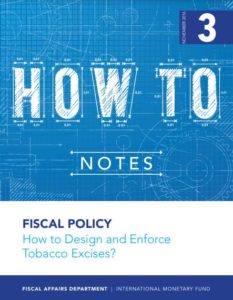
Tobacco is for several good reasons more heavily taxed than other goods in many countries. From the early days of industrial production of cigarettes in the late nineteenth century until a clear link was established between tobacco and various health conditions in the middle of the twentieth century, tobacco was fairly lightly taxed. All this changed with the publication of two governmental reports, in the United Kingdom (Royal College of Physicians, 1962) and the United States (United States Department of Health, Education and Welfare, 1964), in the early 1960s (Yach and Wipfli, 2006). From that point, the wider public came to accept the rationale for tougher tobacco products regulation and, eventually, for higher taxes.
Tobacco-related revenue is generally collected through excise taxes—that is, taxes on the use of a particular product. There are, however, significant variations in both the level and composition of tobacco excises across countries. In the recent past, several countries, such as Canada, some in northern Europe (for example, Sweden, Denmark, Norway), and many Pacific and Caribbean islands, have primarily used specific taxes (a fixed monetary value per physical unit of the excised good), while others, such as China and other East Asian countries, core and southern European countries, and many South American and African ones, relied more heavily on ad valorem taxation (a percentage of the value of the excised good). Many countries use both, but in differing proportions, and with different methods.
Many rationales for taxing tobacco have been invoked, but in fact, most governments tie tobacco excise policy to revenue-raising and health objectives. Other concerns, such as equity or the protection of local industry, for example, have generally been better tackled by the expenditure side of the budget or other policy instruments than by excises. Pursuing revenue or health objectives, however, has direct and significant consequences for both the level and type of excises, and governments should be keenly aware of them when setting policy objectives and designing the excise system.
Tobacco excise receipts vary across countries, but have proved to be a significant and stable source of revenue for many. Tobacco excise revenues are generally low: 0 to 0.2 percent of GDP in most sub-Saharan countries, 0.2 to less than 1 percent of GDP in the Organisation for Economic Co-operation and Development countries and many large developing markets such as Vietnam or the Philippines, and slightly more in some large middle-income markets such as Egypt (1 percent of GDP) and Turkey (1.4 percent of GDP). However, overall tobacco-related revenue can in some cases represent a high proportion of government revenue, especially taking into account the profits of state monopolies: China and Indonesia derived, respectively, 7.6 and 8.4 percent of central government revenue from tobacco in the mid-2000s (Barber and others, 2008; Hu and others, 2008); and the Philippines, Egypt, and Turkey, respectively, 4.2, and 3.7 percent of central government revenue in 2013. Furthermore, in many countries such as Indonesia, high revenue is linked more to high prevalence than to high tax rates, implying significant additional revenue potential.
Taxes can be a powerful instrument to decrease tobacco consumption for health reasons and have therefore been a core component of efforts by the World Health Organization (WHO) and World Bank to curb the tobacco epidemic. With an annual global death toll of over 5 million people, tobacco is one of the most prominent killers of our times. Despite low price elasticity in the short run, the much larger long-run impact of taxes on consumption has motivated a significant surge toward the use of taxes as a way to decrease the burden of tobacco-related diseases (Jha and Chaloupka, 1999; Chaloupka, 2008).
Governments indeed deploy a suite of policies to address tobacco-related health concerns, including regulation (for example, smoke-free environments), public support of tobacco-cessation programs, and, to address informational problems, advertising bans and awareness campaigns, notably. But tax policies have a central role to play (WHO, 2010), and their importance is widely recognized, notably in article 6 of the WHO Framework Convention on Tobacco Control and other international initiatives, such as the Sustainable Development Goals. The underlying rationale for such policies, in terms of both externalities (the adverse effects of smoking on others) and the newer notion of “internalities” (self-control problems) is reviewed in Box 1.
Some key questions recur in the IMF Fiscal Affairs Department’s revenue-related technical assistance work, which covers over 100 countries annually: (1) How high should tobacco taxes be and what are the best ways to tax tobacco? (2) Should tobacco tax revenue be earmarked and, if so, what for? (3) How should tobacco taxes be collected, will they result in illegal trade, and if so how should this be dealt with? These are some of the questions this Note tackles, drawing on the Fiscal Affairs Department’s technical assistance experience as well as a large and sometimes contested literature, and recognizing that most governments around the world are pursuing both revenue and health objectives when they tax tobacco.
To read the full research, please click the download button.
INTERNATIONAL MONETARY FUND

